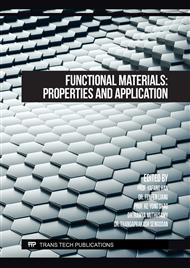p.3
p.11
p.21
p.29
p.37
p.45
p.57
p.67
Experiment and Numerical Simulation on Bearing Properties of Mg-Li Alloy Thread
Abstract:
In order to verify the bearing performance of Mg-Li alloy thread connections, the tightening performance and axial pull-out performance of the Mg-Li alloy thread structure with wire thread insert were tested, and the failure load and mode were obtained. The finite element 2D axisymmetric model was used to numerically analyze the bearing properties of Mg-Li alloy threads. The reliability of the analysis model was verified by comparison with the experimental results and theoretical basis. The load distribution and stress distribution characteristics of the thread connection were studied, and the influence of boundary constraints on the axial pull-out performance was studied. The results show that the M5 Mg-Li alloy embeded wire threat insert with 8 rounds has sufficient connection strength under the action of tightening torque and axial pull-out load, and the failure mode is mainly bolts fracture. Boundary constraints will have an influence on the load distribution and performance of the Mg-Li alloy thread connection structure. The load-bearing ratio of each round thread changes obviously with the downward movement of the top of the boundary. As the top of the boundary moves downward, the location where the maximum load-bearing ratio will be transformed from the first thread to the last thread. The load-bearing ratio of the last thread gradually increases from 11.3% when the outer circumference fully restrained to 23.1% when the boundary area below 4 mm from the last thread. For the M5 Mg-Li alloy embeded wire threat insert with 8 rounds, the axial pull-out bearing capacity of M5 inserts is between 9.5 kN and 12 kN under different boundary conditions.
Info:
Periodical:
Pages:
21-27
Citation:
Online since:
October 2022
Authors:
Price:
Сopyright:
© 2022 Trans Tech Publications Ltd. All Rights Reserved
Share:
Citation:



